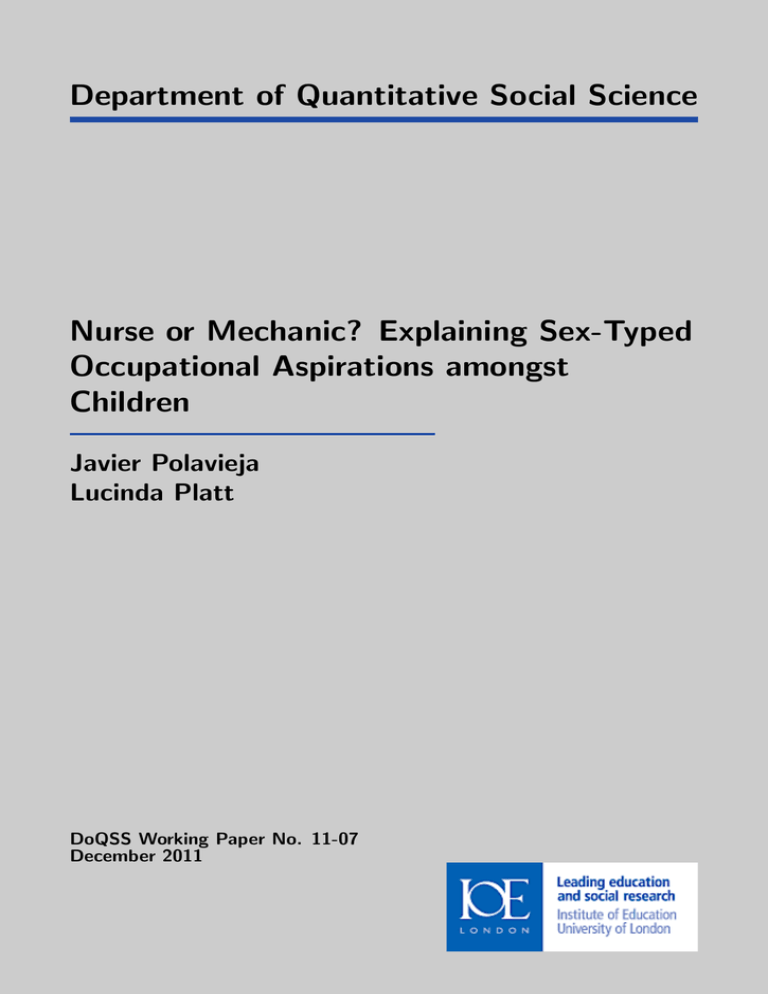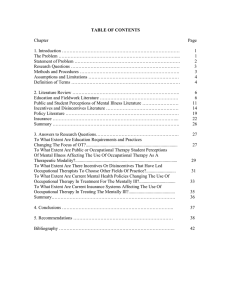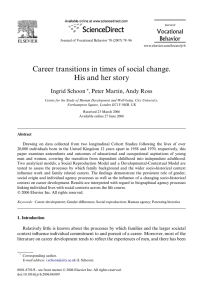Department of Quantitative Social Science Nurse or Mechanic? Explaining Sex-Typed
advertisement

Department of Quantitative Social Science Nurse or Mechanic? Explaining Sex-Typed Occupational Aspirations amongst Children Javier Polavieja Lucinda Platt DoQSS Working Paper No. 11-07 December 2011 DISCLAIMER Any opinions expressed here are those of the author(s) and not those of the Institute of Education. Research published in this series may include views on policy, but the institute itself takes no institutional policy positions. DoQSS Workings Papers often represent preliminary work and are circulated to encourage discussion. Citation of such a paper should account for its provisional character. A revised version may be available directly from the author. Department of Quantitative Social Science. Institute of Education, University of London. 20 Bedford way, London WC1H 0AL, UK. Nurse or Mechanic? Explaining Sex-Typed Occupational Aspirations amongst Children Javier Polavieja∗, Lucinda Platt†‡ Abstract. There is a high degree of sex-typing in young children’s occupational aspirations and this has consequences for adult occupational segregation. Yet we still know surprisingly little about the mechanisms involved in the formation of sex-typical preferences and there is considerable theoretical controversy regarding the relative role of parental socialization and individual agency in this process. This study analyzes the determinants of sex-typed occupational aspirations amongst British children aged between 11 and 15. We develop a model of parental socialization and test for different channels and mechanisms involved in the transmission of sex-typical preferences. We also propose an innovative definition of personal agency that is anchored in observable psychological traits linked to self-direction. We find that parental influences on occupational preferences operate mainly through three distinctive channels: 1) the effect that parental socio-economic resources have on the scope of children’s occupational aspirations, 2) children’s imitation of parental occupations, and 3) children’s learning of sex-typed roles via the observation of parental behavior. We also find a strong net effect of children’s own psychological predispositions —self-esteem in particular— on the incidence of sex-typical occupational preferences. Yet large sex-differences in occupational aspirations remain unexplained. JEL classification: J13, J16, J24, Z13. Keywords: Gender Segregation, Occupational Aspirations, Children, Socialization, Personality Traits. ∗ IMDEA-Social Sciences Institute Institute of Education, University of London ‡ Research for this paper has been supported by the European Centre for Analysis in the Social Sciences, ECASS, the Spanish National Research Council, CSIC and IMDEASocial Sciences Institute. Platt carried out this research while taking up a Marie Curie Intra-European Fellowship at the Institute for Economic Analysis, IAE-CSIC. She is grateful to the European Commission for funding the Fellowship. We also thank Michael Biggs, Stephen Jenkins and Tak Wing Chan for their helpful comments. Address correspondence to javier.polavieja@imdea.org † 0 0 2 2 4 Percent 4 Percent 6 6 8 10 8 Aspired occupations (SOC): Boys Aspired occupations (SOC): Girls 0 0 .5 .5 1 Density 1 Density 1.5 1.5 2 2 2.5 0 .2 .4 .6 Proportion of women: Boys .8 1 0 .2 .4 .6 .8 1 Proportion of women: Girls





